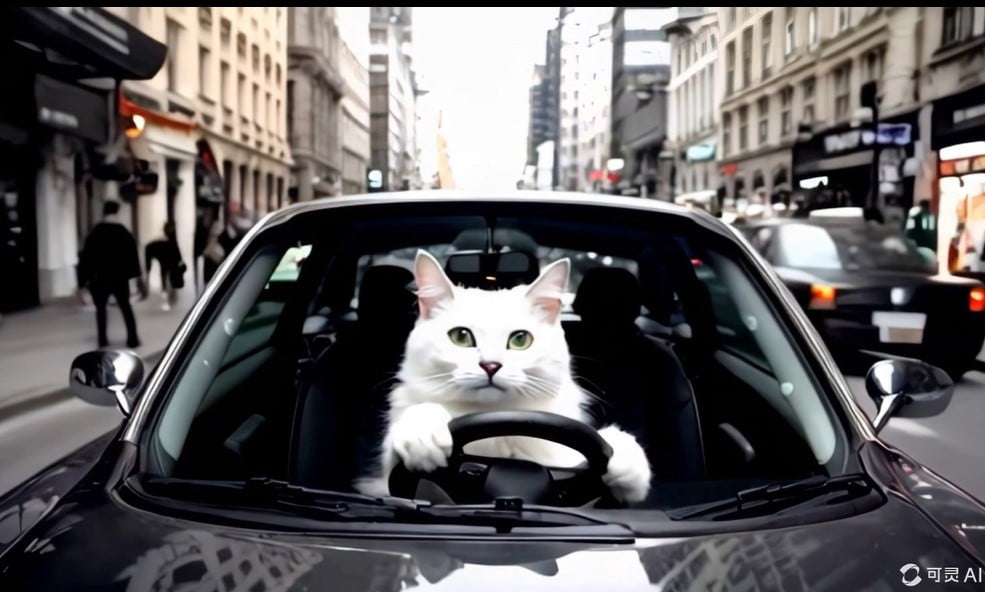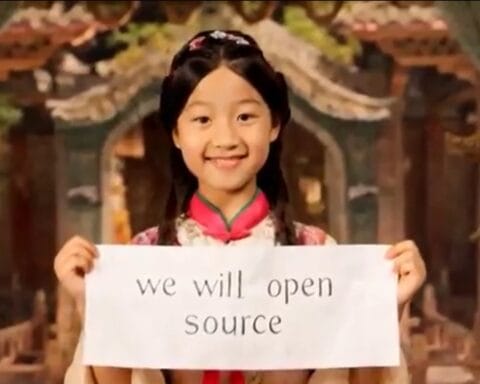Last Updated on July 4, 2024 1:54 pm by Laszlo Szabo / NowadAIs | Published on June 7, 2024 by Laszlo Szabo / NowadAIs
Kuaishou’s AI-Powered Video Generation Model Kling Challenges OpenAI’s Sora – Key Notes
- Kuaishou’s Kling: New AI-powered text-to-video generation model.
- Advanced Technology: Uses Diffusion Transformer and 3D VAE for high-quality video production.
- Video Capabilities: Produces videos up to 2 minutes long in 1080p resolution at 30 fps.
- Simulation Abilities: Accurately models real-world physical properties and interactions.
- Versatility: Blends realistic and imaginative visuals for diverse applications.
- Competitive Landscape: Challenges OpenAI’s Sora and other Chinese models like Dreamina and Vidu.
- Accessibility: Available for public use through Kuaishou’s video editing app, Kuaiying.
- Potential Impact: Could transform filmmaking, advertising, gaming, and virtual reality experiences.
Introduction
In the rapidly evolving world of artificial intelligence, the race to develop cutting-edge generative models has intensified, with tech giants and startups alike vying to push the boundaries of what’s possible. At the forefront of this technological revolution is Kuaishou, the Chinese short-video platform that has recently unveiled its latest creation – Kling, a text-to-video generation model that aims to rival the renowned Sora from OpenAI.
Kling is in the ongoing competition to create AI-powered video generation tools that can transform the creative landscape. As the world eagerly awaits the release of OpenAI’s Sora, Kuaishou has stepped up to the challenge, showcasing Kling’s impressive capabilities that could potentially surpass its highly anticipated competitor.
Kling’s Technical Prowess: Pushing the Boundaries of Video Generation
At the heart of Kling’s technological prowess lies its ability to generate high-quality, long-form videos from simple text prompts. Kuaishou’s AI team has developed Kling using advanced techniques, including the Diffusion Transformer architecture and proprietary 3D VAE (Variational Autoencoder) technology, which enable the model to translate rich textual inputs into vivid, realistic scenes.
One of Kling’s standout features is its capacity to produce videos up to two minutes in length, with a resolution of 1080p and a frame rate of 30 frames per second. This impressive feat surpasses the one-minute video limit of OpenAI’s Sora, showcasing Kling’s ability to create longer, more immersive visual experiences.
Kling’s Simulation Capabilities: Bringing Physical Realism to Life
Kling’s technical prowess extends beyond mere video generation; the model also demonstrates a remarkable ability to simulate real-world physical properties and interactions. Through the implementation of a 3D space-time attention system, Kling can accurately model complex motion sequences and capture the nuances of physical phenomena.
One captivating example showcased by Kuaishou is a video depicting a boy riding a bike through a garden, where the changing seasons are seamlessly integrated into the scene. The model’s attention to detail in capturing the subtle shifts in the environment and the consistency of the boy’s movements are a testament to Kling’s advanced simulation capabilities.
Kling’s Versatility: From Realism to Imagination
While Kling’s prowess in generating realistic videos is undeniable, the model also showcases its ability to blend imagination and creativity. Kuaishou has demonstrated Kling’s capacity to combine diverse concepts and generate fictional scenes, such as a cat driving a car through a bustling city.
This flexibility in transitioning between realistic and imaginative visuals underscores Kling’s potential to revolutionize various industries, from filmmaking and advertising to gaming and virtual experiences. By empowering creators to bring their ideas to life with unprecedented ease and accuracy, Kling opens up new avenues for artistic expression and storytelling.
Kling’s Competitive Landscape: Challenging OpenAI’s Sora and Emerging Chinese Rivals
Kling’s introduction into the market comes at a time when the race for advanced video generation models is intensifying, both globally and within China. While OpenAI’s Sora has garnered significant attention and anticipation, Kling’s emergence as a formidable challenger has sparked a new chapter in this technological rivalry.
Interestingly, Kling is not the only Chinese text-to-video model making waves in the industry. Dreamina, backed by ByteDance, and Vidu, developed by the Beijing-based startup Shengshu Technology, have also unveiled their own versions of Sora-like models, showcasing the country’s growing prowess in this field.
Kling’s Potential Impact: Transforming Content Creation and Beyond
The advent of Kling holds the promise of transforming the landscape of content creation across various industries. By empowering users to generate high-quality, long-form videos with ease, Kling could revolutionize the way we approach tasks such as filmmaking, video production, and even virtual reality experiences.
Moreover, Kling’s ability to simulate physical interactions and blend realism with imagination opens up new possibilities for applications in fields like gaming, education, and even scientific visualization. As the model continues to evolve and be refined, its impact could extend far beyond the realm of video generation, potentially reshaping the way we interact with and perceive the digital world.
Kling’s Accessibility and Availability
Kuaishou has made Kling available for public access through its video editing app, Kuaiying, with Chinese phone number, allowing creators and enthusiasts to experiment with the model and explore its capabilities. This open-access approach sets Kling apart from OpenAI’s Sora, which remains in a more restricted, invitation-only testing phase.
The availability of Kling to a wider audience could accelerate its adoption and spur further advancements in the field of text-to-video generation. As users engage with the model and provide feedback, Kuaishou’s team can refine and enhance Kling’s performance, potentially widening the gap between it and its competitors.
Kling’s Potential Limitations and Challenges
While Kling’s capabilities are undoubtedly impressive, it is essential to acknowledge the potential limitations and challenges that the model may face as it continues to evolve. One key concern is the ability to maintain the consistency and coherence of long-form videos, especially as the duration extends beyond the one-minute mark.
Additionally, the model’s performance in simulating complex physical interactions and seamlessly blending realism with imagination may face limitations, especially as the scope and complexity of the generated content increase. Kuaishou will need to address these challenges through ongoing research and development to solidify Kling’s position as a leading text-to-video generation tool.
Kling’s Regulatory and Ethical Considerations

As with any transformative technology, the development and deployment of Kling raise important regulatory and ethical considerations. Kuaishou, as well as other players in the video generation landscape, will need to navigate the complex landscape of data privacy, content moderation, and potential misuse of the technology.
Ensuring that Kling is used responsibly and in alignment with ethical principles will be crucial as the model becomes more widely adopted. Kuaishou will need to work closely with policymakers, industry experts, and the broader community to establish robust guidelines and safeguards that protect the integrity of the technology and its applications.
Kling’s Future Outlook: Shaping the Next Generation of Content Creation
Want to try the most professional AI video generator? Try Flexclip.com! Tools like AI Text-to-Video, AI Image Generation, and much more!
As Kling continues to evolve and gain traction, its impact on the content creation industry and beyond is poised to be profound. The model’s ability to generate high-quality, long-form videos with ease and realism could fundamentally reshape the way we approach tasks such as filmmaking, advertising, and even educational content development.
Moreover, Kling’s potential to blend imagination and physical realism could open up new avenues for immersive experiences, from gaming and virtual reality to scientific visualization and educational simulations. As the model’s capabilities continue to expand, its influence could extend far beyond the realm of video generation, potentially transforming the very nature of how we create, consume, and interact with digital content.
Kling’s Collaborative Potential: Empowering a New Era of Creativity
While Kling’s competitive edge against OpenAI’s Sora and other emerging models is undoubtedly a focus of attention, the true potential of the technology lies in its ability to empower and collaborate with human creators. By providing a powerful tool that can enhance and accelerate the creative process, Kling has the opportunity to forge a symbiotic relationship with artists, filmmakers, and innovators across various industries.
As Kuaishou continues to refine and expand Kling’s capabilities, the model’s integration with human creativity could lead to unprecedented breakthroughs in content creation, storytelling, and artistic expression. This collaborative approach could not only elevate the quality and diversity of digital content but also inspire new forms of creativity that push the boundaries of what’s possible.
Conclusion: Kling’s Transformative Potential and the Future of Content Creation
The emergence of Kling, Kuaishou’s groundbreaking text-to-video generation model, marks a significant milestone in the ongoing quest to push the boundaries of what’s possible in the realm of artificial intelligence. By showcasing its ability to create high-quality, long-form videos with realistic simulations and imaginative flair, Kling has positioned itself as a formidable challenger to OpenAI’s Sora and other emerging players in the video generation landscape.
Definitions
- Kling Video Generator: An AI-powered tool developed by Kuaishou that generates high-quality videos from text prompts, using advanced technologies like Diffusion Transformer and 3D VAE.
- Kuaishou: A popular Chinese short-video platform and tech company known for its innovative AI-driven products.
- AI Video Generators: Tools that use artificial intelligence to create videos based on input data such as text descriptions, enabling automated content creation.
- Character Consistency: The ability of an AI model to maintain visual and behavioral consistency in characters across different scenes and actions.
- OpenAI’s Sora: A text-to-video generation model developed by OpenAI, known for its high-quality video production capabilities.
- Bytedance’s Dreamina: An AI-powered video generation model developed by ByteDance, similar to OpenAI’s Sora.
- Shengshu Technology’s Vidu: Another Chinese text-to-video generation model developed by Shengshu Technology, competing in the same space as Kling and Sora.
Frequently Asked Questions
- What is Kuaishou’s AI-Powered Video Generation Model Kling? Kling is an advanced AI-powered text-to-video generation model developed by Kuaishou. It produces high-quality videos from simple text prompts, making it a versatile tool for content creators.
- How does Kling compare to other AI video generators like OpenAI’s Sora? Kling stands out with its ability to generate videos up to two minutes long in 1080p resolution, compared to Sora’s one-minute limit. Additionally, Kling excels in simulating real-world physical interactions and blending imaginative scenes.
- What are the key features of Kling’s video generation capabilities? Kling uses Diffusion Transformer architecture and 3D VAE technology to produce realistic and imaginative videos. It supports high-quality video generation with a resolution of 1080p and a frame rate of 30 fps, and can simulate complex motion sequences.
- How can users access and use Kling for their projects? Kuaishou has made Kling accessible through its video editing app, Kuaiying. This allows users to experiment with Kling’s capabilities and generate their own videos using simple text prompts.
- What industries could benefit from using Kling? Kling has the potential to transform various industries, including filmmaking, advertising, gaming, virtual reality, and education. Its ability to generate high-quality, imaginative videos can enhance creative processes and storytelling.









